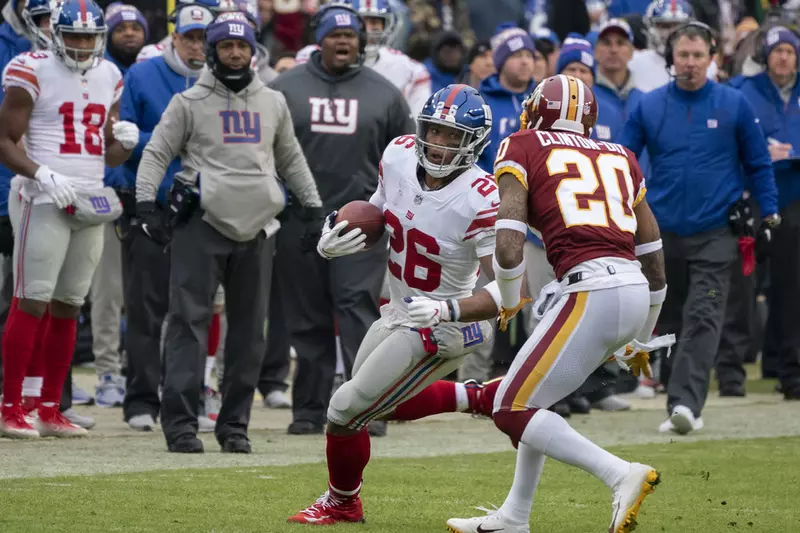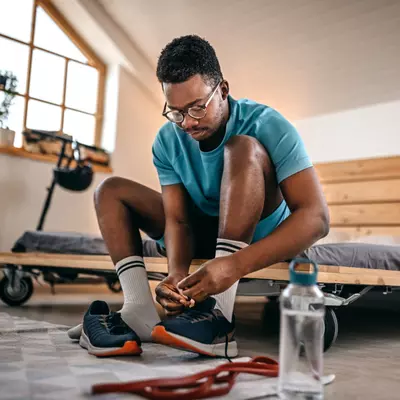- AdventHealth

Giants star running back Saquon Barkley was recently diagnosed with a high ankle sprain, which could see him sidelined anywhere from four to six weeks. So what does this mean for Saquon and how soon can he expect to heal?
For starters, let's clarify the difference between a strain and a sprain. A sprain occurs when a ligament (connective tissues, like elastic bands that connect the end of one bone to another and also keep your joints in place) is stretched or torn. It's common to feel a pop or tear when this happens. A strain is a stretched or torn muscle or tendon (tissue connecting muscle to the bone).
The good news is: You can sometimes treat the pain of strains and sprains at home. Here are some expert tips to determine when you need to seek out a medical professional, and what you can do to strengthen your muscles in your feet, ankles and any other affected areas.
Sprains and strains can happen in a variety of circumstances. Everything from overuse injuries (working out/playing sports too long without proper rest) to twisting/pulling something to sustaining an unfortunate fall can lead to a sprain or strain. There's no one activity that causes injuries more than others.
How Sprains and Strains Happen
A sprained ankle can occur when your foot turns inward, placing extreme tension on the ligaments of your outer ankle. A sprained knee may be the result of a sudden twist, and a sprained wrist can occur when you fall on an outstretched hand.
A strain can occur similar to a sprain, where it may be a simple stretch in your muscle or tendon; or it may be a partial or complete tear in your muscle/tendon connection.
What are the signs of a sprain?
- Bruising
- Decreased range of motion
- Instability of the joint
- Pain
- Swelling
What Are the signs of a strain?
- Bruising (either immediately or a few days later)
- Inflammation
- Muscle cramping
- Muscle spasm
- Muscle weakness
- Pain
There are things that you can do in the first 24 to 48 hours to help alleviate pain and begin the healing process. You should rest, protect the injured area, use crutches or other assistive devices as needed to help immobilize, compress (not too tight), elevate, and apply ice for 15–20 minutes at least every two hours.
If you don't see any improvement in a couple of days, you should see a medical professional to evaluate the extent of your injury.
How Sprains and Strains Are Diagnosed
Most sprains and strains are diagnosed by a physical exam. Your medical professional will exam the affected joint or muscles and take you through your normal range of motion, watching for pain, tenderness, weakness or instability.
If there's a chance you've broken a bone, an X-ray may be ordered. An MRI may be needed to determine the extent of your injury because soft tissue, where sprains and strains occur, don't show up on X-rays.
Healing Sprains and Strains
How long a sprain or strain typically takes to heal varies based on the severity of your injury and how much you're still using the area after the injury. Recovery ranges from a couple of days to a few weeks.
In 2013, the National Athletic Trainers Association issued a position statement that ankle injuries should never be taken lightly and are too often mistreated or not treated at all. This can result in an ankle prone to problems, prolonged discomfort and possible re-injury, which can mean further reduced physical activity levels.
And with an injury that never gets better, whether it's your ankle or another area, it can become easy to slip into the habits that of a sedentary lifestyle, which can then to further long-term health complications.
Preventing Sprains and Strains
Regular stretching and strengthening exercises can help minimize your risks of sprains and strains and improve motion in all areas of the body. You can use a variety of stretching techniques to make sure you have full range of motion at all joints and lessen your chances of injuries too. And, using a foam roller can help with stretching and mobility.
Progressive strengthening exercises allow you to better stabilize yourself during activity. Balancing exercises train your body to know where it is in space and reduce your injury rate. Other tips for preventing sprains and strains include:
- Be in the right physical condition for the sport you're playing
- Eat healthy to keep your muscles strong
- Exercise daily
- Keep a healthy weight
- Keep your home safe to prevent slips and falls
- Run on flat surfaces to prevent tripping
- Try to exercise or play sports when you're alert and not tired
- Wear protective gear when playing sports
- Wear the right shoes for the sport you're playing
For more information about sprains and strains or to speak with a physical therapist, visit AdventHealth Sports Med and Rehab.



